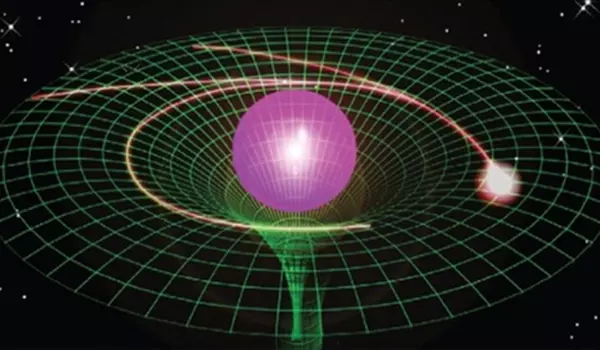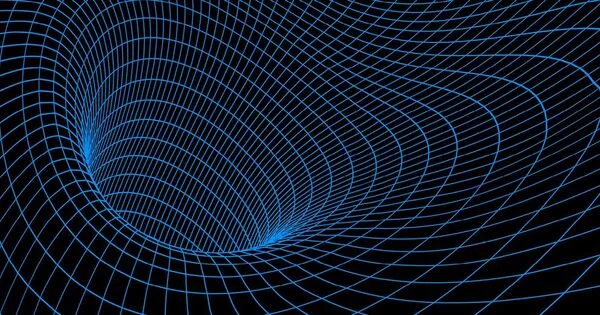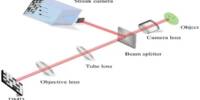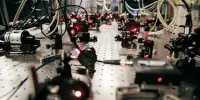Curved spacetime is a concept introduced by Einstein’s general theory of relativity, which describes gravity as the curvature of spacetime caused by the presence of matter and energy. While the effects of curved spacetime can be simulated in classical computer models using numerical techniques, doing so in a quantum simulator is a more difficult task.
The relationship between quantum physics and the theory of relativity is extremely difficult to study. However, scientists have created a model system that can assist: Quantum particles can be tuned in such a way that the results can be translated into information about other systems that are much more difficult to observe. This kind of ‘quantum simulator’ works very well and can lead to new insights about the nature of relativity and quantum physics.
When it comes to explaining cosmic-scale phenomena, such as gravitational waves created when black holes collide, the theory of relativity works well. When describing particle-scale phenomena, such as the behavior of individual electrons in an atom, quantum theory works well. However, a completely satisfactory combination of the two has yet to be achieved. The search for a “quantum theory of gravity” is regarded as one of science’s most significant unsolved problems.
We take a quantum system that we know we can control and adjust very well in experiments. In our case, these are ultracold atomic clouds that are held and manipulated by an atom chip with electromagnetic fields.
Jörg Schmiedmayer
This is due in part to the highly complex mathematics involved in this field. At the same time, it is difficult to conduct suitable experiments: One would have to create situations in which phenomena from both relativity theory, such as a spacetime curved by heavy masses, and quantum effects, such as the dual particle and wave nature of light, become visible.
At the TU Wien in Vienna, Austria, a new approach has now been developed for this purpose: A so-called “quantum simulator” is used to get to the bottom of such questions: Instead of directly investigating the system of interest (namely quantum particles in curved spacetime), one creates a “model system” from which one can then learn something about the system of actual interest by analogy.
The researchers have now shown that this quantum simulator works excellently. The findings of this international collaboration involving physicists from the University of Crete, Nanyang Technological University, and FU Berlin are now published in the scientific journal Proceedings of the National Academy of Sciences of the USA (PNAS).

Learning from one system about another
The basic idea behind the quantum simulator is simple: Many physical systems are similar. Even if they are entirely different kinds of particles or physical systems on different scales that, at first glance, have little to do with each other, these systems may obey the same laws and equations at a deeper level. This means one can learn something about a particular system by studying another.
“We take a quantum system that we know we can control and adjust very well in experiments,” says Atomic Institute at TU Wien Prof. Jörg Schmiedmayer. “In our case, these are ultracold atomic clouds that are held and manipulated by an atom chip with electromagnetic fields.” Assume you adjust these atomic clouds properly so that their properties can be translated into another quantum system. In that case, the measurement of the atomic cloud model system can teach you something about the other system, much like the oscillation of a pendulum can teach you something about the oscillation of a mass attached to a metal spring: they are two different physical systems, but one can be translated into the other.
The gravitational lensing effect
“We have now been able to show that we can produce effects in this way that can be used to resemble the curvature of spacetime,” says Mohammadamin Tajik of the Vienna Center for Quantum Science and Technology (VCQ) – TU Wien, the current paper’s first author. Light propagates in the vacuum along a path known as a “light cone.” Light travels the same distance in each direction at equal times because its speed is constant. However, when light is influenced by heavy masses, such as the gravitational pull of the sun, these light cones bend. In curved spacetimes, light’s paths are no longer perfectly straight. This is known as the “gravitational lens effect.”
The same can now be shown in atomic clouds. Instead of the speed of light, one examines the speed of sound. “Now we have a system in which there is an effect that corresponds to spacetime curvature or gravitational lensing, but at the same time, it is a quantum system that you can describe with quantum field theories,” says Mohammadamin Tajik. “With this, we have a completely new tool to study the connection between relativity and quantum theory.”
A model system for quantum gravity
The experiments show that the shape of light cones, lensing effects, reflections, and other phenomena can be observed in these atomic clouds in the same way that they would be expected in relativistic cosmic systems. This is not only interesting for generating new data for basic theoretical research; solid-state physics and the search for new materials encounter questions with similar structures that can be answered by such experiments.
“We now want to better control these atomic clouds in order to determine even more distant data.” “For example, interactions between particles can still be changed in a very targeted manner,” Jörg Schmiedmayer explains. In this way, the quantum simulator can recreate physical situations that are so complex that even supercomputers cannot calculate them.
















